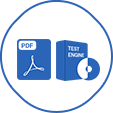Last Update 5 hours ago Total Questions : 124
The ABPMP International Certified Business Process Associate (CBPA) Exam content is now fully updated, with all current exam questions added 5 hours ago. Deciding to include CBPA practice exam questions in your study plan goes far beyond basic test preparation.
You'll find that our CBPA exam questions frequently feature detailed scenarios and practical problem-solving exercises that directly mirror industry challenges. Engaging with these CBPA sample sets allows you to effectively manage your time and pace yourself, giving you the ability to finish any ABPMP International Certified Business Process Associate (CBPA) Exam practice test comfortably within the allotted time.
The feasibility of blockchain by industry depends on the type of
Which statement is true regarding process modeling?
During change projects, top management is NOT responsible for
What are the best options for testing new processes at the end of a process design activity?
Why do organizations need a process repository?
What is important when creating a new process?
Which are the two types of Center of Excellence (CoE) for process governance?

